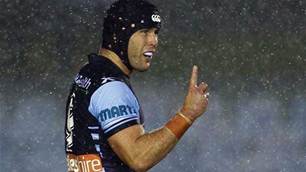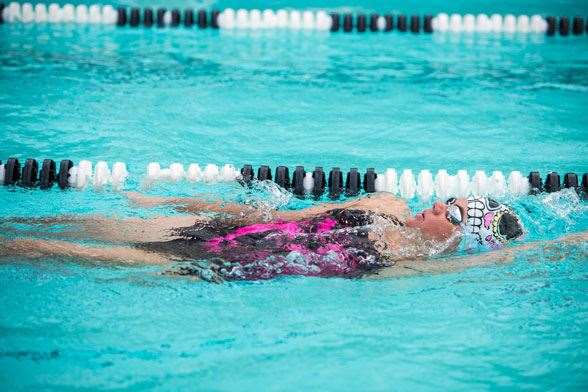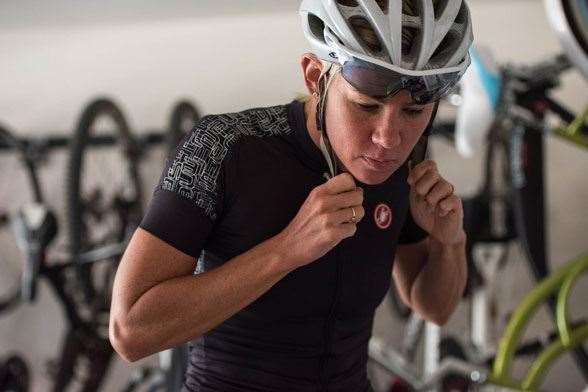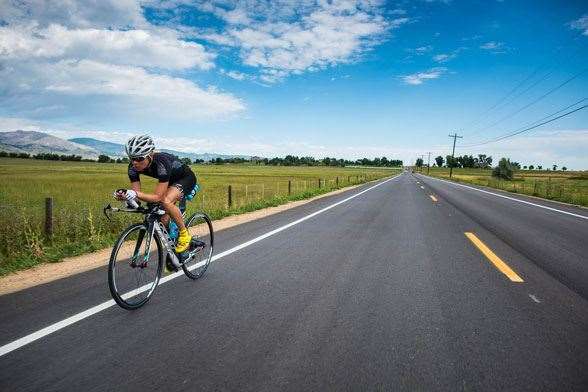How this ultra-triathlon superstar stays at the top of her game.
For 35 years the words “Kailua-Kona” have sent shivers down the spines of the world’s greatest endurance athletes. It’s where a devastatingly beautiful Hawaiian backdrop of steamy, active volcanoes, oven-baked lava fields and Corona-campaign sunsets mask the most gruelling one-day sporting event in the world – triathlon’s Ironman World Championship. Over the years the course has cruelly challenged super-athletes to take on its 3.8km swim leg, 180km bike stage and 42km marathon-distance run. Its many disciples, like Australia’s Mirinda Carfrae, consider it the ultimate test of personal strength, resolve and endurance.
Carfrae, who collects regular wins on the 70.3 half-Ironman circuit, has finished on the podium at the Kona World Championship every year since 2009 when she was runner-up. In 2010 she improved on that the only way possible, scoring her first victory, backing that up with another second in 2011 and a bronze in ’12. This year the Queenslander will again descend on Kona as its defending champion, spurred on by memories of her winning effort in 2013 when she set a new women’s course record of 8 hrs, 52 minutes and 14 seconds (she also set a new run leg benchmark of 2:50:38). Training out of Boulder, Colorado, the 33-year-old is well and truly playing her part in keeping alive the legacy of Aussie women’s success at Kona. She runs in the trails blazed by 2006 champion Michellie Jones and Kate Major, who collected a sequence of bronze between 2004 and ’07. Here’s how Australia’s current superstar prepared for her assault on back-to-back Kona wins, which she achieved when she took out the 2014 event, proving herself as one of the true greats of the sport.
HOME AND AWAY
“I came over to the US in 2005 just to enter some races. People like Loretta Harrop were based in Boulder, and a lot of other endurance athletes as well. It seemed to be the place to go. I absolutely loved it. It’s more similar to Europe than America in that we’re right by the mountain.
“Boulder is a college town, so it has a kind of fun atmosphere. The training conditions are perfect. You have flat areas and the mountains, as I said, are right there. The air is thinner up here; we’re at 1600m altitude. From our house we’d hit maybe one traffic light and then we’re off for a five-hour ride, which is awesome. There are tonnes of dirt trails close to town as well which we can do our long runs on, and a couple of really good aquatic centres where we can swim, so it’s really set-up for endurance athletes.
“I go back to Australia every year; we tend to train up at Noosa on the Sunny Coast. All my family is still in Brisbane, where I spend a bit of time before I head up the coast, usually for two-three months during the Colorado winter. Once that arrives, the days here get very short ... and it’s a bit cold for us Aussies who don’t know how to deal with snow so well.”
MULTI-TASKING
“I race a bunch of different distances. I like doing Olympic-distance triathlons, half-Ironmans, and then obviously Kona, the Ironman. For me, the World Championships is the most important race of the year. I base my whole calendar around that. I sit down at the end of the year and plug in races that make financial sense for me to race in, as well as those which fit in with my preparation for Kona. My current block of training is pretty intense and super-hard. If I wasn’t in great shape going into this block, I’d probably break down or just wouldn’t be able to handle it after a couple of weeks.”
DIFFERENT STROKES
“Every training day is slightly different for me. Some days I might just run and swim, or I might bike and run and not swim ... but typically, I try to swim six days a week. I’m not a great swimmer. I didn’t have a swimming background, so I need to hop in the water as much as possible. I run six days a week; some of those days I’ll run twice. And I bike typically five days a week. In terms of hours, that would be anywhere from 30-35 hours’ training a week all up. I’d probably spend about 15 hours on the bike, eight-nine running and the rest would be swimming. That’s probably 450km on the bike, 100km running and maybe 23-24km swimming a week. It seems kind of crazy when you step back and look at it, but that’s the world I’m in. It’s become quite normal to me.”
RISE AND SHINE
“I don’t love early mornings, but triathlons usually start at 7.30am. The earliest session I have is probably 6.30am. We do a lot of our harder work in the mornings, from 7am-noon; that’s where we’re doing our higher-quality, intense training. The afternoons are typically a lot easier; I enjoy doing a lighter session, whether it be an easy spin on the bike or a 30-40 minute jog. I find it therapeutic. It’s more like a recovery session at the end of the day than full-on training. I’m definitely more of a night person.”
COOL RUNNINGS
“Everyone finds their own running technique that works best for them. I’m pretty small, only five-three. For the marathon ‒ and especially getting off the bike then running a marathon after exercising for five-six hours ‒ it’s important to clock a high turnover or high cadence. Your efficiency becomes more important the longer the event goes on. For me, I just try and find a really good rhythm in my run and once I get into it, I just kind of tick away. I guess I do focus on my breathing, but no one has ever told me how to breathe or whether I should be breathing in through my mouth and out through my nose, etc. I just try to relax and get the air in. I’m fortunate in that running is my strength; it came naturally. I didn’t ever do drills or have anyone teach me to run. I just kind of knew. Everybody has their own natural talent in life; mine’s running off the bike in triathlons!”
MIND GAMES
“If you’re having a great day, the race goes by really quickly; you’re in the moment, focussed. It’s the days where you’re struggling to focus when time slows; these are the Ironman or long-course events that really suck. I visualise Kona in race mode all year-round in training; I know what it feels like. This is my sixth time there this year. Once I get there I kind of switch to auto-pilot, but at the same time focussing on measuring my output. It’s a little under a nine-hour event on a good day and you only have so much energy to expend for the whole day, so you’re watching your competitors, but also trying to give as much as possible without falling into the red or expending too much energy. You’re constantly asking yourself questions. Am I going too hard? Can I go harder? Am I at a good pace? Am I eating enough? Am I absorbing what I’m eating? You’re going through a system check to make sure everything is intact, as it should be.”
MUSCLE WORK
“I try to do two gym sessions a week. I started working with a personal trainer two years ago. We target any muscle or muscle groups that are slightly weaker or not firing correctly. I’m not hitting the gym and pumping big iron, trying to build muscle or anything. I’m looking to stay as lean as possible; I don’t want to carry any more extra weight. But I still need to make sure the muscles I do have are firing in the right order and they’re all switched on.
“I’m pretty lucky in that I haven’t suffered a single injury my whole career, which began in 2000 at my first triathlon. I think my body is built for this kind of training. If I feel like, ‘Okay, my calf is a little tight today,’ maybe I’ll keep an eye on that, get some treatment and loosen it up before it becomes an issue. The big danger in triathlon training is overreaching or overtraining. You want to get in as much work as possible, but obviously there’s a limit to how much your body can absorb and take on before you’re just giving it too much and become fatigued and run into all sorts of other issues; getting sick and so forth. You learn to spot signs of exhaustion. If you have a couple of consecutive days like that, you know to back off for a few days and let the body absorb the work you’ve done so that you can get back wholly into your routine.”
CONQUERING KONA
“Whenever I go to Kona and touch down on the island ... it’s just a special place. I always get off that plane and the heat and humidity hit ‒ and I just feel like I’m back in Brisbane in summer. It just makes me happy. I know there are other athletes who, when the heat hits them, they’re like, ‘Oh God, this sucks!’ “I mean, there have been amazing athletes who have melted down at the end of that race before; past champions who have missed out on a few gels, got their in-race nutrition mixed up, or haven’t quite been at the top of their game. The island commands your respect. I always go in to the race with a lot of respect for the island and the conditions it may or may not throw at us that day. You do need to go in with a bit of confidence as well; to know you’ve done the work and you deserve to be there and that you have what it takes to win if you get everything right.”
WEIGHT WELCOME
“Since I’ve been doing Ironman, the focus of my diet has been keeping the weight on. My husband Tim [O’Donnell, US triathlon champion] and I pretty much eat whatever we want at home. I don’t like being on diets or things like that; we train and work hard enough that we should be able to relax outside training. We enjoy drinking wine; a few drinks with dinner most nights. We have ice cream pretty much every night of the week, but that’s to load up on those calories. As I mentioned, we’re training 30 hours a week; it’s sometimes hard to replace those calories you’re losing all the time. We’re eating pretty clean. We’re not going to fast food joints, but once in a while we’ll have some if we really feel like it.
“Typically, six-eight weeks out from Kona, I cut out the ice cream, cut out the wine. For me, that’s a mental switch that says: ‘Okay, this is the business end of the season.’”
MILKING IT
“A protein drink can be very handy ‒ if you can find a good one. I just drink Chocolate Milk because they sponsor me and drop 600ml bottles of it ‒ 20 of them ‒ on my front doorstep every two weeks. It’s a great recovery drink. Sometimes I’ll add a protein powder to it. I’ve used Ascend in the past, but that’s such a pain in the butt because it’s made in Australia; it’s hard to send over here. I’m too scared to try any of the American products because you have to be so careful with the supplements you’re taking; a lot of them aren’t ‘pure’. Obviously you don’t want to return positive on a drug test for a random protein powder that might’ve been mixed with an illegal substance. I try to stay clear of many medications. I take Coenzyme Q10, and just a multi-vitamin and that’s about it. I get all my vitamins from Australia, just because I know they’re clean; what’s on the label is what’s in the jar.”
MORNING AFTER
“When Kona’s all over, I don’t do a thing for a week. I cross that finish line ... and usually spend a little bit of time in the medical tent. For me, it’s more about having a mental break than anything else. I’ll sit on the beach, drink cocktails. It probably takes at least three weeks before you’re close to full recovery.
“You definitely suffer from that deep fatigue in your quads, for sure. I feel it for a couple of weeks after an Ironman. But I also feel it in my heart and lungs. When you’ve competed in an Ironman event and your heart’s been beating at a very high level for that long ... it’s a muscle, right? It suffers damage like your quads, calves and all your other muscles that are working. I think sometimes the heart is overlooked.”
Related Articles

Mirinda Carfrae – Kona champion

Training with the Cronulla Sharks' Michael Ennis























